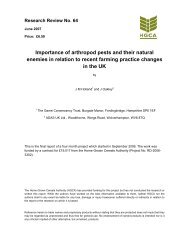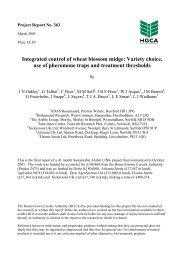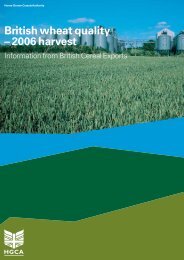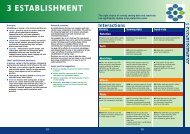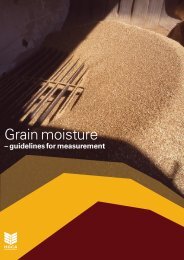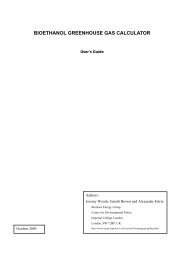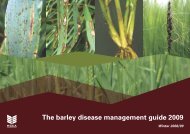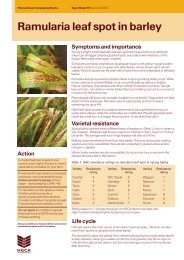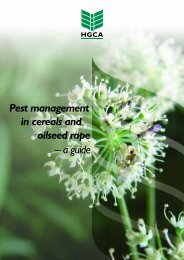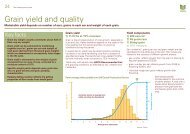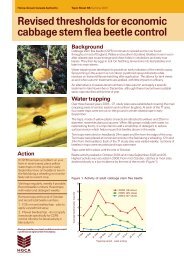G38 Wheat disease management guide 2009 - HGCA
G38 Wheat disease management guide 2009 - HGCA
G38 Wheat disease management guide 2009 - HGCA
Create successful ePaper yourself
Turn your PDF publications into a flip-book with our unique Google optimized e-Paper software.
Seed production and certificationCertified seedAll seed bought and sold in the UK must be certified.<strong>Wheat</strong> quality standards (including varietal and speciespurity, germination, loose smut and number of pieces ofergot) are prescribed in the Cereal Seed Regulationswhich are issued as statutory instruments by the UKgovernments within the EU-wide framework. Theseprescribe minimum quality standards but also allowmember countries to set stricter standards.In the UK, ‘HVS’ (Higher Voluntary Standard) seed iscertified to higher standards for varietal and speciespurity, ergot contamination and loose smut. HVS seedis sold at a premium over EU standard seed.Seed can be certified at various stages as a variety iscommercialised. Certified seed of the secondgeneration (C2) is the normal category for commercialcrop production.Certification and seed-borne <strong>disease</strong>The Cereal Seed Regulations state: “Harmful organismswhich reduce the usefulness of the seed shall be at thelowest possible level.”Standards exist for loose smut, currently rare in UKwheat, and ergot but there are none for seed-bornebunt or fungal seedling blights. Although not arequirement of certification, in practice most certifiedseed is treated; which <strong>disease</strong>s are controlled dependson the treatment.Farmers must declare any use of farm-saved seed tothe British Society of Plant Breeders (BSPB). Mostvarieties are eligible for payment; the list is available atwww.bspb.co.uk. Payments must be made via aregistered processor or directly to BSPB. Paymentsfor previously zero rated varieties will be refundedimmediately but declarations of these varieties aresubject to verification by BSPB.Note, by law farm-saved seed cannot be sold,shared or bartered.Organic seed productionOrganic certified seedmust meet the samequality standards asconventionally producedseed. No conventional seedtreatments should be usedon organic certified orfarm-saved seed. All seedconsidered for organicproduction should be testedfor seed-borne <strong>disease</strong>s.Farm-saved seedQuality seed can be grown and processed on farm.The aim should be to meet at least the minimumcertified seed standards.The wheat <strong>disease</strong> <strong>management</strong> <strong>guide</strong> <strong>2009</strong>4
Seed sampling and testingBy law, seed must be officially sampled and testedbefore it can be certified. Sampling and testing are alsoimportant for grain intended for farm-saved seed.Sampling– Sample grain before cleaning or drying; ideally with asingle or multi-chamber stick sampler.– Wash equipment with water and detergent, beforeand between lots, where there is a risk of buntcontamination.– Keep grain intended for sowing separate from largergrain bulks.– Only use seed from one field to reduce variabilitywithin a seed lot.– Sub-divide seed lots over 30 tonnes into smaller lots.– Sample across the bulk, or trailer, at different depths(see table below for number of samples required).– Thoroughly mix all samples from a lot in a cleanbucket; divide to create a composite sample fortesting.Primary samples required for given lot sizesLot size (tonnes)Under 5* 105 1010 2020–30 40Primary samples required*Seed treatment should only be used where necessarybut with small seed lots it may be cheaper to treat than tosample and test for seed-borne <strong>disease</strong>s.Germination testingLow germination, due to <strong>disease</strong>, sprouting, drying,mechanical or chemical damage, is a major cause ofpoor quality in UK seed. Where time is limited thetetrazolium test (TZ) is recommended. However, thisdoes not detect low germination caused by <strong>disease</strong>damage, but gives a good indication of potentialgermination after treatment for seedling blights.Regulatory standards and advisory thresholdsDisease Method Duration Results given asBunt Wash 48 hours Spores per seedMicrodochium seedlingblightMolecular test 48 hours Either over or under1 spore/seedSeed health testing– Never sow untreated seed without testing for seedborne<strong>disease</strong>s, particularly bunt and Microdochiumseedling blight.– Test for ergot, loose smut, Septoria seedling blightand Fusarium graminearum if a problem issuspected.Regulatory S tandardA dvisory thresholdA Treat if 1 spore/seed or moreAgar plate 7–10 days % infection A Treat if over 10%Molecular 48–72 hours Either over or under infection10% infectionSeptoria and Fusarium Agar plate 7–10 days % infection A Treat if over 10%seedling blightsErgot Visual 500g 24 hours Number of pieces Maximum pieces:or 1000g in 500g or 1000g A S 3 pieces/500gsearch– minimum standardS 1 piece/1000g – HVSLoose smut Embryo 48 hours % infection in Maximum infection:extraction 1000 embryos (advisory) or A S 0.5% – minimum2000 embryos (certification) standardS 0.2%–HVSTreat for seedling blights when sum of infection levels exceeds 10%.At present seedling blight caused by Cochliobolus sativus is a low risk in UK wheat.The wheat <strong>disease</strong> <strong>management</strong> <strong>guide</strong> <strong>2009</strong>5
Seed-borne <strong>disease</strong>sBunt Tilletia triticiThe wheat <strong>disease</strong> <strong>management</strong> <strong>guide</strong> <strong>2009</strong>SymptomsSymptoms appear after earsemerge. Plants are oftenstunted and sometimes haveyellow streaks along the flagleaf. Infected ears are darkgrey-green with slightlygaping glumes. Bunt ballsreplace all grains and, ifbroken, release millions ofblack spores smelling ofrotten fish.ImportanceBunt occurs at low levels in some seed stocks.Contaminated grain may cause rejection.Life cycleSpores on the seed surface germinate with seeds.After invading shoots and growing points, the fungusgrows within the plant until ear emergence when buntballs replace grain. The spores contaminate healthygrain during harvest, transport and storage. Sporescan land on soil or spread by wind to neighbouringfields. Soil-borne spores can invade seedlings veryearly in germination.Risk factorsSeed-borne infection:– Seed repeatedly sown without a fungicide treatment.– Seedbed conditions leading to slow emergence.Soil-borne infection:– Very short time between harvesting first wheat andsowing second wheat.– Dry soil conditions between harvesting and sowing.Microdochium seedling blightMicrodochium nivale and majusSymptomsThe most common symptom of a serious attackis poor establishment. The fungus can also cause rootrotting, brown foot rot, leaf blotch and, in combinationwith Fusarium species, ear blight.ImportanceIn most years Microdochium seedling blight occurs onwheat seed and is the most important cause of seedlingblight in the UK. Sowing untreated seed with high levelsof infection causes very poor crop establishment leadingto yield loss.Life cycleInoculum (spores) are found in soil and on infectedseed. Spores, released when seedling blight or stembasebrowning occurs, are splashed up the plant andultimately infect the ear.Risk factors– Wet weather during flowering.– High level of seed infection.– Untreated seed sown into poor seedbeds.– Late-sown crops.Septoria seedling blightPhaeosphaeria nodorumSymptomsThe most common effect is poor plant establishment.Symptoms are so similar to those of Microdochiumseedling blight that only laboratory analysis candistinguish them. Septoria nodorum is more commonlyassociated with necrotic blotching of leaves and glumes.ImportanceEffects of Septoria seedling blight are usually lesssevere than Microdochium seedling blight. However, athigh levels crop establishment can be badly affected.Life cycleWhile the <strong>disease</strong> can survive on plant debris, mostinfections result from seed-borne inoculum.Risk factors– High seed infection levels.– Untreated seed sown into poor seedbeds.– Cool, wet soils.6
Seed-borne <strong>disease</strong>sFusarium seedling blightFusarium graminearumSymptomsPoor plant establishment is the most common effecttogether with root rotting, brown foot rot and ear blight.ImportanceAt present Fusarium graminearum is the only Fusariumspecies that causes significant seedling losses in the UK.Life cycleInoculum occurs mainly on crop debris, but can be seedborne.Spores are splashed up the plant to infect ears.Risk factors– High levels of seed infection.– Sowing untreated seed into poor seedbeds.– Maize in the rotation.ErgotClaviceps purpureaSymptomsA hard, purple-black sclerotium, up to 2cm long, replacessome grains in the ear.ImportanceYield is hardly affected but ergot is highly poisonous toman and animals, so contaminated grain will be rejected,or require cleaning. Standards for number of ergot piecesexist for certified seed.Life cycleAt or near harvest, ergots fall to the ground, or arespread with contaminated seed. They remain dormantuntil the following summer, when they germinate andproduce spores, encased in sticky ‘honeydew’. SporesThe wheat <strong>disease</strong> <strong>management</strong> <strong>guide</strong> <strong>2009</strong>spread by wind to open grass and cereal flowers nearby.Rain splash or insects carry spores to other flowers,leading to further infection.ControlNo fungicide is effective against ergot. In the absence ofhost crops, ergots decay over 12 months. Check weedgrasses and field margins for ergot. Consider ploughingbetween host crops and break crops. Control cerealvolunteers and grass weeds.Risk factors– Grass weeds, particularly black-grass.– Cool, wet conditions during flowering.– Prolonged flowering periods.– Late tillering.Seedling blight, foot rotand leaf spotCochliobolus sativusSymptomsEarly symptoms include brown roots and coleoptiles.Infected plants with brown spotting on lower leavesusually grow to maturity. Severe infections causestem-base rotting and poorly filled ears.ImportanceCochliobolus sativus is traditionally a <strong>disease</strong> of hotterclimates. Symptoms only occasionally occur in the UK.Life cycleThe soil and seed-borne fungus survives on crop debrisand grass weeds. It sometimes causes seedling blight.More usually it infects roots but the plant survives.Splash-borne spores infect seed in ears.Risk factors– Any factor that slows germination and emergence,eg poor seedbeds.– Extended periods of warm, moist weather.Loose smutUstilago nuda f. sp. triticiSymptomsThe ear is usually completelyreplaced by black fungalspores. Sometimes ears arepartly affected. Spores arereleased as soon as the earemerges leaving a bare earrachis with total grain loss.Blackened ears are soobvious that very lowincidences appear severe.ImportanceSeed certification and resistant varieties have minimisedseed-borne infection.Life cycleThe fungus is present inside the embryo. As seedgerminates the fungus grows within the plant andinfects the ear at an early stage. Eventually spikeletsare replaced with masses of fungal spores which arereleased at ear emergence. Spores spread by wind tonearby open flowers and infect developing grain siteson healthy plants.Risk factors– Cool, moist conditions during flowering.– Infected neighbouring crops.– Seed repeatedly sown without treatment.7
Seed treatment – To treat or not to treatCertified seedFarm-saved seedGermination test85% plus 78–84% Under 78%Considering sowinguntreated?Is heat damagepresent?YESTest seed for bunt and Microdochium seedling blight.Test for Septoria seedling blight if Septoria nodorumpresent in the growing crop.NONOYESDO NOTUSE FORSEEDDoes bunt exceed 1 spore/seed?YESNODo combined seedling<strong>disease</strong>s exceed 10%?YESNOVery low risk of seed-borne <strong>disease</strong>.Consider sowing seed untreated.Treat seed withan appropriateproduct(see page 9)High infection of Microdochium seedling blight (left)The wheat <strong>disease</strong> <strong>management</strong> <strong>guide</strong> <strong>2009</strong>8
Seed treatment – Product choiceSeed-borne <strong>disease</strong>sOther <strong>disease</strong>sActive ingredient Product Bunt Seedling Loose Ergot Bunt Blue Take- Yellow Septoria Brown Virus vectorblights smut soil-borne mould all rust tritici rust controlcarboxin, thiram Anchor Chclothianidin Deter Byclothianidin, prothioconazoleRedigo Deter Bydifenconazole, fludioxonil Celest Extra Syfludioxonil Beret Gold Syfludioxonil, flutriafol Beret Multi Syfludioxonil, tefluthrin Austral Plus Syfluquinconazole Galmano Byfluquinconazole, prochlorazGalmano Plus Byfluquinconazole, prochloraz Jockey Bsfluquinconazole, prochloraz Epona Bsfluoxastrobin, prothioconazole Redigo Twin Byfuberidazole, imidacloprid,triadimenolTripod PlusMAfuberidazole, triadimenol Tripod MAguazatine Ravine MAipconazole Crusoe Chprothioconazole Redigo Byprochloraz, triticonazole Kinto Bssilthiofam Latitude Mo✓✓✓✓✓✓✓✓✓✓✓✓✓✓✓✓✓Key to company: Bs=BASF By=Bayer CropScience Ch=Chemtura Mo=Monsanto MA=Makhteshim-Agan Sy=Syngenta✓✓✓✓✓✓✓✓✓✓✓✓✓✓✓✓✓✓✓✓✓✓✓✓✓✓✓✓✓✓✓✓✓✓✓✓✓✓✓✓✓✓✓✓✓✓✓✓✓✓✓✓✓✓✓✓✓✓✓✓✓✓✓✓✓✓✓✓✓✓✓✓✓✓✓✓✓✓✓✓✓✓✓✓✓✓✓✓✓✓ label recommendation✓ some known activity, but nolabel recommendationThe wheat <strong>disease</strong> <strong>management</strong> <strong>guide</strong> <strong>2009</strong>9
Foliar <strong>disease</strong>s – Impact on yield formationMost foliar <strong>disease</strong>s accelerate senescence of the top three leaves and so reduceyield. Fungicide sprays during canopy growth prevent green leaf area loss duringgrain filling.Construction phaseCanopy growth: Canopy expansion accelerates in April/May as temperaturesrise and large upper leaves emerge. The maximum green area of leaves andstems (measured as green area index – GAI) is reached as ears emerge, justbefore grain filling begins.Stem reserve accumulation: During stem extension, stored solublecarbohydrates accumulate in the stem.Applying sprays during this critical phase – at T1 (GS32) and T2 (GS39) – limits<strong>disease</strong> progress and protects emerging upper leaves, so maximisingphotosynthesis later.Production phaseGrain filling: In this six to seven week period, up to 80% of yield comes fromphotosynthesis. On bright days, yield typically increases by 0.2t/ha/day. In thisphase, stem reserve relocation accounts for 20% of grain filling.A fungicide at full ear emergence may help prevent premature leaf loss.Canopy size (GAI)7654321025Slow expansion Rapid expansion SenescenceSoil-borne, seed-borne,root and stem-base<strong>disease</strong>s reduce canopyestablishment andexpansionT1T2Sprays applied tocontrol foliar <strong>disease</strong>sFoliar <strong>disease</strong>s causeearly senescence, lossof GAI and yieldCrop protectedfrom <strong>disease</strong>DiseasedJan Feb Mar Apr May Jun Jul Aug SepT3GS30 GS32 GS39 GS59 GS71HealthyFlag leaf and ear contribute 65% of total yieldTotal above-ground dry matter (t/ha)2015105Emergenceof the final4 leavesWatery ripe GS71Flowering GS61Flag leaf emerged GS39Hard dough GS87HealthyFirst node GS310Foundation phase Construction phase Production phaseThe wheat <strong>disease</strong> <strong>management</strong> <strong>guide</strong> <strong>2009</strong>10
Foliar <strong>disease</strong>s – Infection and developmentInitial infectionInfection usually results from spores moving into the crop. When this occursdepends on the <strong>disease</strong>. For example by spring, Septoria tritici is present on the lowerleaves of most crops.Latent periods, fungicide activity and spray timingExample based on Septoria triticiGS32Leaf 3 just emergedGS33Leaf 2 just emergedGS39Flag leaf emergedGS59Ear emergedDisease developmentInfection is followed by a ‘latent period’ when the fungus grows within the leaf butthe leaf exhibits no symptoms.The cycle of leaf emergence, infection, latent period and symptom expression appliesto all foliar <strong>disease</strong>s. The latent period varies considerably between pathogens and isaffected by temperature. At higher temperatures, latent periods are shorter.Septoria tritici has a very long latent period (14–28 days). Many modern fungicidescan control <strong>disease</strong> after a leaf becomes infected but only for about half of thelatent period. In the summer, Septoria tritici may have a latent period of 14 days, butfungicides provide eradicant control for only about seven days. Although there may beno symptoms on a leaf, infection may be so far into the latent period that nofungicide at any dose will control the fungus.Leaf 3First spores arrive10–14 daysFirst spores arriveLeaf 2Leaf 3Latent infection(no symptoms)10–14 daysFirst spores arriveLeaf 2Leaf 3Latent infection(no symptoms)Leaf 1 Leaf 1(flag leaf)Latent infection(no symptoms) Leaf 2First lesion10–14 daysLeaf 3First lesionSevere lesionsImportance of spray timing and latent periodSpore landson leafFungus penetratesleafFungicides effective in this periodNo <strong>disease</strong> symptoms visibleThe wheat <strong>disease</strong> <strong>management</strong> <strong>guide</strong> <strong>2009</strong>Fungus growsinside leafLatent periodFungal growth beyondchemical controlSymptoms appearon leafLatent periods can be as short as 4–5 days for mildew and brown rust. Strategiesto manage these <strong>disease</strong>s depend largely on protecting leaves as they emerge.Leaf 4 and belowalready showingsymptoms. Disease onthese leaves cannotnow be controlled.Leaf 3 can beprotected.Leaf 3 infected but<strong>disease</strong> still in latentperiod and controllable.Leaf 2 just infected.Leaf 3 may now beshowing symptoms –<strong>disease</strong> not nowcontrollable on this leaflayer.Leaf 2 infected but stillin latent period, so<strong>disease</strong> controllable byflag leaf sprays.Symptoms now visibleon leaves 2 and 3, notcontrollable by earsprays. Ear sprays topup protectant activity onthe flag leaf.Infection from within cropsAs stems extend and upper leaves emerge, the crop tends to grow away from the<strong>disease</strong>. Newly emerged leaves always appear free from Septoria tritici betweenGS32 and GS39. However, the crucial final three leaves are at risk as soon as theyemerge. By this stage, most inoculum comes from within the crop and sporemovement from other fields is much less important. Rusts and powdery mildewhave very short latent periods and can be found before leaves have fully expanded.In the absence of fungicide use, the final severity of <strong>disease</strong> is determined byvariety and weather.11
Foliar <strong>disease</strong>s – Spray timingFoliar treatmentsTo ensure adequate protection of the key yield forming leaves, fungicide treatmentsshould be targeted to leaf emergence, rather than growth stage. Full emergence ofleaf 3 usually coincides with GS32 but this can vary between crops. Very earlysowing can lead to leaf 3 emerging as late as GS33, but leaf 3 may emerge at GS31in late-sown crops. Thus, leaf emergence is the best <strong>guide</strong> for decisions on spraytimings. With practice, this can be assessed quickly in the field. Growth stagesprovide a second best option.Spray windowThe ‘spray window’ for effective <strong>disease</strong> control on a particular leaf layer isrelatively narrow. The optimum spray timing is when a leaf has just fully emerged.– Spraying too early, when the leaf is not fully emerged, results in insufficient sprayon the leaf and thus poor control.– Spraying too late means the <strong>disease</strong> is already established and results in poorcontrol, especially with protectant fungicides.Main timingsT1 timing – Leaf 3 emerged (usually coincides with GS32, but can be as early asGS31 or as late as GS33).T2 timing – Flag leaf emerged (GS39)Applying both T1 and T2 sprays at optimal timings gives effective <strong>disease</strong> control onthe top three leaves – those most important in grain filling.Additional timingsT0 timing – Usually two to four weeks earlier than T1.Instances where a T0 spray may be considered include:– to delay Septoria tritici development– where mildew, yellow or brown rusts are active– when eyespot requires earlier treatment.T3 timing –- Ear sprayMay be used to control ear <strong>disease</strong>s and 'top-up' foliar <strong>disease</strong> control on the flagleaf on susceptible varieties under high <strong>disease</strong> pressure.The wheat <strong>disease</strong> <strong>management</strong> <strong>guide</strong> <strong>2009</strong>Effects of spray timing on <strong>disease</strong> controlThe optimum T1 spray gives maximum<strong>disease</strong> control on leaf 3, and providessome protection for leaf 2.Disease control (%)Disease control (%)Disease control (%)100806040200100806040200100806040200T1The optimum T2 spray gives maximum <strong>disease</strong>control on the flag leaf and eradicates any latentinfections on leaf 2 that have escaped earlier sprays.Effects of spray timings on <strong>disease</strong> controlThe figures above were produced from trials. Sprays were applied at frequent intervalsacross a range of growth stages. Each curve shows the level of control achieved oneach of the top three leaves for the spray timings from GS31 to GS59. The intervalbetween T1 and T2 is important. Disease control on upper leaves will be lost if theinterval extends beyond three weeks, especially when <strong>disease</strong>s with short life cycles,eg rusts or powdery mildew, are active.12T2Flag leafLeaf 2Leaf 3GS31 GS32 GS33 GS39 GS59Time of spray application
Foliar <strong>disease</strong>s – Septoria triticiMycosphaerella graminicolasometimes known as leaf blotchSymptomsIn autumn andwinter, brown ovalleaf spots (lesions)occur on olderleaves whichcontain thediagnostic smallblack fruiting bodies(pycnidia). Severallesions may turnlarge areas of leafbrown. In spring andsummer, lesions areusually rectangularand confined by leafveins. Leaf lesions are often surrounded by areas of leafyellowing or death. During rapid development, watersoakedlesions gradually turning brown may be present.ImportanceSeptoria tritici is the most damaging foliar <strong>disease</strong>of UK wheat, causing significant yield loss every year.Infection occurs in all crops. Unusually dry weatherthroughout May and June may reduce losses. Higherrainfall areas in the south and west are most at risk.National survey data over the past ten years indicatesthat crops had an average of 5.3% Septoria tritici on leaf2 at GS75, despite treatment, representing an annualyield loss worth £49 million (at £100/t).Life cycleAirborne spores disperse in autumn/winter from previouswheat stubbles. These ascospores infect leaves toproduce leaf spots from mid-autumn onwards and thenspread by rain splash and physical contact betweenleaves.In autumn and spring,crops infected byairborne ascosporesascosporesSpread of pycnidiospores up plantsby contact and rain splashOverwinters as mycelium, pycnidiaand pseudothecia on crop debris,autumn-sown crops and volunteersPseudothecia and pycnidiadevelop within lesionsperithecia(wind blown)pycnidia(rain splash)Heavy rainfall encourages rapid spore movement fromlower to upper leaves during stem extension. Optimumtemperatures are 15–20ºC.Symptoms appear after a latent period (14 – 28 days afterinfection); this period reduces as temperatures rise.Risk factors– Susceptible varieties.– Early sowing.– Rainfall: high risk Septoria periods occur during‘splashy’ or prolonged rain, especially in May andearly June.Mild winters and wet, windy conditions in early springincrease risk.ControlVarietiesThe <strong>HGCA</strong> Recommended List contains varieties withresistance ratings from 4 to 7 so a fungicide treatmentis likely to be necessary in most instances. However,a lower dose is required for effective control on moreresistant varieties.CulturalAvoid very early sowing of susceptible varieties.FungicidesControl relies on using robust rates of azole fungicidesat T1 and T2, usually in mixture with a protectantfungicide with a different mode of action,eg chlorothalonil, boscalid.Resistance to strobilurin products is widespread andthey are unlikely to be effective.Some systemic seed treatments (eg fluquinconazole)may give limited early control.The wheat <strong>disease</strong> <strong>management</strong> <strong>guide</strong> <strong>2009</strong>13
Foliar <strong>disease</strong>s – Septoria nodorumPhaeosphaeria (Stagonospora)nodorumsometimes known as leaf and glume blotchSymptomsOn leaves, symptomsare mainly oval brownlesions with a smallyellowish halo. Palebrown, rather thanblack, pycnidiadistinguish Septorianodorum fromSeptoria tritici. Theindistinct brownpycnidia may be onlyvisible when lesionsare held up to the light.Under high <strong>disease</strong>pressure, leafsymptoms can includesmall purplish-brownspots.On ears, symptoms are typically purplish-brown blotcheson glumes.ImportanceAlthough Septoria nodorum is widespread, it is now rarefor severe attacks to occur; when they do it is usuallyassociated with high rainfall at ear emergence (eg southwestBritain). Here yield losses in untreated crops mayexceed 50%.Life cycleIn spring, crops also infected bypycnidiospores and ascosporespycnidiosporesascosporesSeed infection causes dampingoff and early infection of plantLeaves and ear infected bycontact and rain splashSeed infectionOverwinters on cropdebris, grass weeds andvolunteersThe pathogen survives in crop residues, volunteers andwild grasses. It can be seed-borne. Airborne ascosporesfrom wheat stubbles spread infection to newly-emergedcrops.Secondary spread occurs when pycnidiospores,produced within leaf spots, are dispersed by rain splash.Symptoms appear within 7–14 days. The <strong>disease</strong> candevelop very rapidly in warm temperatures (20–27ºC)with long periods (6–16 hours) of high humidity.Risk factors– Susceptible varieties.– High rainfall during and after ear emergence.– South-west and coastal locations.ControlVarietiesThe <strong>HGCA</strong> Recommended List contains varietieswith resistance ratings from 4 to 9. Resistant varietiesare preferred in high risk areas.CulturalPloughing or cultivation to bury crop residues afterharvest may provide some control.FungicidesT1 and T2 sprays applied to control other <strong>disease</strong>susually control Septoria nodorum on the leaves. Whenrisk is high, a T3 protectant ear spray is important.The wheat <strong>disease</strong> <strong>management</strong> <strong>guide</strong> <strong>2009</strong>14
Foliar <strong>disease</strong>s – Yellow (stripe) rustPuccinia striiformisSymptomsGroups of yellowpustules formingstripes betweenveins are the mainsymptoms. Underhot, dry conditions –or after fungicideuse – pustules maybe difficult to detect.In spring, smallpatches (foci)of leaves withscattered yellowpustules precederapid spreadthroughout the field.Ears can also beaffected.ImportanceSevere epidemics can occur when large areas ofsusceptible varieties are grown. In untreated,susceptible varieties, yellow rust can reduce yields byover 50%. However, well-timed fungicide sprays areusually very effective so annual losses are small.Outbreaks often occur in coastal areas from Essex tothe Borders and central England.Life cycleEpidemics are associated with mild winters that enablethe pathogen to overwinter in crops and volunteers.Cold winters with severe frosts restrict its survival.Pustules eruptreleasinguredosporesEarly infection of plantsby wind-borne uredosporesSpringSummerDiseasespread bywinddispersalOverwinters onvolunteer plantsLate in the season blacktelia form on leavesAutumnTeliospores producebasidia andbasidiospores (noalternate host known)In early spring distinct foci may occur; secondary spreadis through airborne spores as well as leaf-to-leaf contact.Cool (10–15ºC), damp weather, with overnight dew orrain, provides optimum conditions for <strong>disease</strong>development.UK weather conditions are unlikely to limit developmentin spring or early summer. Symptoms appear 7–14 daysafter infection so leaf tips may show symptoms beforeleaves fully emerge. Hot, dry weather with temperaturesover 25°C limit development.Risk factors– Large variation between years in epidemic risk.– Overwinter survival is critical.– Problems occur after mild winters and on susceptiblevarieties.– Cold winters with several frosts below -5ºC reducesurvival.– New races continue to develop that overcome themajor gene resistance of some new varieties.ControlVarietiesVarieties with resistance ratings of 7 and 8 on the<strong>HGCA</strong> Recommended List give effective control andmay be less prone to sudden loss of resistance thanvarieties with a rating of 9. The wheat yellow rustdiversification scheme is designed to help growerschoose combinations of varieties in such a way as toreduce the risk of crop loss due to <strong>disease</strong> spreadingfrom one variety to another.CulturalControl volunteers that provide a ‘green bridge’ betweenharvest and emergence of new crops.FungicidesAzole and most strobilurin products are very effective.Systemic seed treatments (eg fluquinconazole ortriadimenol) may delay epidemic development whererisk is high.The wheat <strong>disease</strong> <strong>management</strong> <strong>guide</strong> <strong>2009</strong>15
Foliar <strong>disease</strong>s – Brown (leaf) rustPuccinia triticinaSymptomsMost commonlyseen as tinyorange-brownpustules scatteredover leaves. Duringautumn and winterfew pustules,confined to olderleaves, may beseen. While thepustules can bea similar colourto those of yellowrust, they usuallyhave a chlorotichalo.Late in the season brown rust can become very severeand cause leaf death. Leaf sheaths and ears are alsoaffected. Black spots occur on maturing crops whenpustules produce a second, teliospore stage.ImportanceThere is large seasonal and geographic variation inbrown rust severity. The <strong>disease</strong> is more common insouthern and eastern England on susceptible varieties.National survey data over the past ten years indicatesfarm crops had an average of 0.15% brown rust onleaf 2 at GS75, representing an annual yield loss worth£1.4 million (at £100/t). In 2007, a season when brownrust was prevalent, the cost was £11.2 million.Life cycleBrown rust overwinters in crops and on volunteers. Itspreads by means of airborne spores. Cold winters mayreduce its survival.Pustules of brown urediaerupt from the leafreleasing uredosporesSlow <strong>disease</strong> developmentin spring – infection bywind-borne uredosporesMost rapid spreadoccurs at hightemperature, latein the seasonOverwinters onvolunteersTeliospores producebasidia and basidiospores.Aecidial stagefound on alternatehost (Ornithogalum)but rare in UKLate in the season blacktelia form on leaf surfaceOptimum conditions are days with high temperatures(15–22ºC) followed by overnight dews. Surface moistureon leaves is essential for spore germination.Symptoms can appear in 5–6 days at optimumtemperatures. The <strong>disease</strong> is active over a wider rangeof temperature (7–25ºC) than yellow rust.Risk factors– Seasonal weather – the <strong>disease</strong> is normally mostactive when June and July temperatures are high.(However, in 2007 above average springtemperatures led to unusually early epidemics.)– High humidity is necessary for epidemic progress.– Susceptible varieties.– Early sowing.– New races continue to develop that overcome themajor gene resistance of some new varieties.ControlVarietiesResistant varieties provide good control. Varieties on the<strong>HGCA</strong> Recommended List have ratings from 3–9. Thesecan change over time as new races of brown rust appear.Most current UK wheat varieties are very, or moderately,susceptible, but some have good resistance.CulturalControl volunteers that provide a ‘green bridge’ betweenharvest and emergence of new crops. Susceptiblevarieties should not be sown early in September.FungicidesProducts containing azoles and strobilurins are veryeffective. In a programme, treatment intervals shouldnot exceed three to four weeks; they should besubstantially shorter under high <strong>disease</strong> pressure.Systemic seed treatments (eg fluquinconazole ortriadimenol) may help delay epidemics developing whererisk is high. However, seed treatments are likely toprovide less control of brown rust than yellow rust.The wheat <strong>disease</strong> <strong>management</strong> <strong>guide</strong> <strong>2009</strong>16
Foliar <strong>disease</strong>s – Tan spotPyrenophora (Drechslera)tritici-repentisSymptomsTan spot symptomsare variable. Smalltan, or brown, flecksdevelop into palebrownoval spotswith dark centres.These lesionssometimes havea chlorotic halo.Numerous lesionscan coalesce intolarge necrotic areas.Symptoms are verysimilar to those ofSeptoria nodorumand diagnosisrelies on sporeidentification.Life cycleLike Septoria nodorum, tan spot is trash-borne andfavoured by minimum tillage. Ascospores produced onstubble, probably in spring, introduce the <strong>disease</strong> intocrops. Leaf lesions appear in 7–14 days and producesplash-dispersed asexual spores.Rain splashmovesconidiaup plantcausingre-infectionPrimary infection resultsfrom conidia and ascosporesTypical eyeshapedleafspottingsymptomsoccurOverwinters asseed-bornemyceliumand aspseudotheciaon crop debrisAt end of seasonpseudotheciadevelopControlVarietiesResistance ratings are not currently available.CulturalPloughing or cultivation to bury infected crop residues.FungicidesFungicidal control is difficult due to the short latentperiod.Strobilurin resistance in tan spot has been confirmedelsewhere in Europe, and is likely to be present inthe UK.ImportanceTan spot is still a minor UK <strong>disease</strong>, but appears to bebecoming more common. Some severe cases haveoccurred in recent years. It is a major problem inSweden, Denmark, Germany and France, and it isperhaps surprising that tan spot is not more widespreadin the UK.High temperatures (20–28ºC) and rain causing longperiods of leaf wetness are ideal for tan spotdevelopment.Risk factors– Minimum and non-inversion tillage.– Long periods of wet weather from GS32 onwards.The wheat <strong>disease</strong> <strong>management</strong> <strong>guide</strong> <strong>2009</strong>17
Foliar <strong>disease</strong>s – Powdery mildewBlumeria graminisSymptomsWhite fluffy colonies ofpustules often occuron leaves from autumnonwards.On yellowing leaves,pustules retain adistinctive ‘greenisland’. Severemildew can coveralmost the entire leafsurface and developon ears and stems.Later in the season,pin-head sized, blackfruiting bodies(cleistothecia) thatproduce sexual spores (ascospores) may be found onthe white colonies.ImportanceMildew can develop over a wide range of conditions butis sporadic, often affecting crops under stress. Althoughvery visible, it generally reduces yield much less thanother foliar <strong>disease</strong>s. Damaging attacks can occuranywhere in the UK, but yield losses rarely exceed 10%.National survey data over the past ten years indicatesthat farm crops had an average of 0.2% mildew on leaf2 at GS75, representing an annual yield loss worth£1.9 million (at £100/t), despite treatment.Life cycleAirborne conidia, produced on crops or volunteers,enable mildew to spread widely. Warm (15–22ºC),breezy conditions with short periods of high humidityfavour infection. New pustules are produced in5–14 days.Mycelium develops on young plantsand conidiophores release conidiaIn spring, conidia and ascosporesstart early infectionsRe-infection of leaf layersby airborne conidiaOverwinters as mycelium andcleistothecia on autumn-sowncrops and wheat volunteersCleistothecia developon lower leavesTemperatures over 25ºC and rain can inhibitdevelopment. Sexually-produced spores provide amechanism for summer survival when leaf growthhas slowed.Risk factors– Susceptible variety.– Sheltered fertile sites.– High nitrogen.– Warm dry, but humid, weather.ControlVarietiesMost recommended varieties show moderateresistance although Claire is rated 4 on the<strong>HGCA</strong> Recommended List.CulturalAvoid excessive nitrogen fertilisation.FungicidesFungicides with specific activity against mildew arerequired where powdery mildew is a particular threat.Some treatments, applied at T0 or T1, provide long-termprotection. Fungicide resistance is known to affect theperformance of various fungicide groups (eg strobilurins,azoles, morpholines).The <strong>HGCA</strong>/BASF Encyclopaediaof Cereal Diseases(www.hgca.com/cde) providesinformation on <strong>disease</strong>identification.<strong>HGCA</strong>/Bayer CropMonitor(www.cropmonitor.co.uk)provides information on<strong>disease</strong> prevalence and risk.The wheat <strong>disease</strong> <strong>management</strong> <strong>guide</strong> <strong>2009</strong>18
Root <strong>disease</strong>s – Take-allGaeumannomyces graminisvar. triticiSymptomsTake-all can infect plantsat a low level withoutcausing obvioussymptoms. However,moderate or severeinfection reduces thenumber of active rootsover winter, whichrestricts canopy growth.Infection of the crown(adventitious) roots inthe spring and early summer restricts water and nutrientuptake, resulting in patches of whiteheads (bleachedears) as grain fills.ImportanceTake-all is the major cause of ‘second wheat syndrome’when yields of second wheat crops are frequently10–15% less than those of first wheats.Take-all is usually most severe in the second to fourthsuccessive cereal crop, but generally yields recover tosome extent in continuous cereals – ‘take-all decline’.Take-all causes most damage on light soils where lossof active roots has a large effect on water and nutrientuptake.Even on chalky boulder clay soils with high waterholding capacity, losses of 10% are common in secondand third wheat crops. On less well-bodied soils yieldlosses can be much higher, so it may be uneconomicto grow second or subsequent wheat crops.Risk factors– High pH increases <strong>disease</strong> risk.Severe attacks can also occur in acid patches. Poordrainage, low nutrient status and particularly earlysowing and light, puffy seedbeds, encourage the<strong>disease</strong>.Cereal volunteers and grass weeds, especially couch,in break crops will carry the <strong>disease</strong> through tofollowing cereals.ControlCulturalControl relies largely on rotation and good soil<strong>management</strong> and husbandry. Reducing the severity insecond and subsequent wheats is achieved by delayingdrilling compared with first wheats, and maintaininggood soil structure and nutrient levels.VarietiesAll varieties are susceptible to take-all but some aremore tolerant in the presence of <strong>disease</strong>. The <strong>HGCA</strong>Recommended List yields for second wheats givesome guidance to choosing the most suitable varietiesfor second and subsequent sowings. Yield responsesreflect take-all tolerance and eyespot resistance.Varieties known to perform well as second wheatsinclude Grafton, JB Diego, Duxford, Ketchum andBattalion.FungicidesSeed treatments, based on silthiofam andfluquinconazole, can help to reduce the effects oftake-all, particularly when used in conjunction withcultural control measures. Seed treatments do not alterthe optimum sowing date, but can delay the take-allepidemic, and reduce the yield penalty from sowingsecond wheats early.Azoxystrobin or fluoxastrobin applied at T1 timing canhelp suppress take-all.Yield (t/ha)Seed treatment does not alter optimum sowing date8.07.87.67.47.27.06.86.66.4Optimum sowing date for second wheatswith or without treatmentSilthiofamUntreated1 Oct 11 Oct 21 Oct 31 Oct 10 Nov 20 NovDrilling date<strong>HGCA</strong>-funded trials, ADAS RosemaundSee Take-all in winter wheat –<strong>management</strong> <strong>guide</strong>lines,<strong>HGCA</strong> (2006).The wheat <strong>disease</strong> <strong>management</strong> <strong>guide</strong> <strong>2009</strong>19
Stem-base <strong>disease</strong>sStem-base <strong>disease</strong>s can be difficult to distinguish,particularly early in the season when treatmentdecisions are made. Identification is necessary becauseeyespot is much more important than sharp eyespot(Rhizoctonia cerealis) and Fusarium foot rot. Duringstem extension, lesions caused by Fusarium and sharpeyespot are generally confined to the outer leaf sheath.Some fungicides give incidental sharp eyespot controlbut specific treatment is difficult to justify.EyespotOculimacula acuformis (R type)Oculimacula yallundae (W type)SymptomsEyespot affects the stem base of winter wheat fromautumn onwards. Lesions appear as red-brown blotches.Mixed R and W type eyespot infections occur in mostUK crops. Symptoms may disappear as leaf sheaths dieoff during spring growth, but can reappear later.ImportanceEyespot reduces yield and quality by restricting waterand nutrient uptake. Yield losses may be large,particularly in early-sown crops. Severe eyespot cancause lodging from weakened stems. Even withoutlodging, severe eyespot can reduce yield by 10–30%.Risk factorsEyespot development in crops is difficult to predict. Theneed for control can be based on estimating <strong>disease</strong> riskusing local experience of incidence and weather. SeeTopic Sheet 80. The visible presence of eyespot at stemextension is not the only indicator of risk. Risk isincreased by ploughing, a preceding wheat or cerealcrop in the rotation, heavy soils, and early sowing.There is a strong weather influence on <strong>disease</strong>development. Wet springweather increases risk.ControlVarietiesEyespot-resistant varietieson the <strong>HGCA</strong> RecommendedList include Battalion, Claire,Deben, Grafton, Humber,Istabraq, Scout and Timber.FungicidesGood control is difficult toachieve and may be affectedby the type of eyespotpresent. Many treatmentsonly reduce severity.Mean spring rainfallover 170mmunder 170mmProthioconazole or boscalid (the latterin mix with epoxiconazole), control both eyespot andSeptoria tritici well – a useful option at T1. Higherdoses are usually required for eyespot control. Specificeyespot treatments should be applied at GS30-31 ifhigh risk justifies early treatment.Yield response to foliar <strong>disease</strong> control usually exceedsresponse from eyespot treatment. However, delayingtreatment until GS32 – for better <strong>disease</strong> control onleaf 3 – may compromise eyespot control, especiallyif <strong>disease</strong> levels are high on susceptible varieties.Some control may be achieved at GS37 if eyespot hasnot penetrated the stem base.Estimating your eyespot riskWith funding from <strong>HGCA</strong>, SAC devised an eyespotrisk model, summarised below, to help winter wheatgrowers.Factor Level RiskpointsSowing date Before 6 October 5After 6 October 0Eyespot infection Under 7% tillers infected 0at GS31–32 Over 7% tillers infected 10Mean rainfall (mm) Under 170mm 0in March/April/May Over 170mm 5Tillage Minimum tillage 0Plough 10Soil type* Light 0Medium 1Heavy 5Previous crop Non-cereal 0Other cereal 10<strong>Wheat</strong> 15* add a further 5 points for brash and limestone soilsUse the table to estimate your total risk points. Thisapproach gives you the flexibility to decide on the levelof risk that you will accept.Interpreting your total risk pointsLow riskThreshold if you accept minimum riskThreshold if youaccept higher riskHigh risk0 20 29 40Increasing need for treatmentThe wheat <strong>disease</strong> <strong>management</strong> <strong>guide</strong> <strong>2009</strong>20
Ear <strong>disease</strong>sDiseases can affect grain quality byreducing grain filling, leading to lowspecific weights and shrivelled grain.Infections of Fusarium andMichrodochium species may result inmycotoxins. Sooty moulds, and similar<strong>disease</strong>s, may affect grain appearancecausing rejection for milling.Foliar <strong>disease</strong>s that affect the earSeptoria nodorum is potentially themost damaging to yield. In south-westEngland, foliar and ear infections cancause yield losses of up to 70%.Yellow rust, in severe cases, infectsears.Brown rust can also affect ears.Powdery mildew, although very obviouson ears, does not cause large yieldlosses.Specific ear <strong>disease</strong>sSooty moulds are caused by a mixtureof fungi, mainly Cladosporium andAlternaria species, which grow onglume surfaces in wet weather or onprematurely ripened ears. They causelittle yield loss but can discolour grain,which affects marketability, particularlyfor milling.Fusarium ear (or head) blights arecaused by a range of Fusarium speciesand Microdochium nivale andMicrodochium majus. In recent years,there has been concern about the linkbetween ear blights and the formationof mycotoxins.In UK wheat, the main mycotoxinproducingspecies are Fusariumculmorum, Fusarium graminearum andFusarium avenaceum which all producesimilar symptoms. The presence of earblight is not a good indicator of likelymycotoxin risk in UK crops.Legislation imposes a limit fordeoxynivalenol (DON) in grain forhuman consumption of 1250 partsper billion. In most years few UK grainsamples have exceeded this limit.Risk of mycotoxin formation can increase if:– maize preceded the wheat cropNB ploughing maize residues reducesrisk– wet weather occurred duringflowering.Fungicide treatment can help reduce earblight and mycotoxin risk provided therecommended rate is used as near toinfection time as possible.Seed-borne ear <strong>disease</strong>sDetails of <strong>disease</strong>s such as bunt, ergotand smut can be found at pages 6 and 7.Control of ear <strong>disease</strong>sSprays applied after ear emergence:– top-up protection for flag leaf andleaf 2 against foliar <strong>disease</strong>– protect the newly-emerged ear againstfoliar <strong>disease</strong>s– protect against specific ear <strong>disease</strong>s– limit mycotoxin accumulation.Sprays applied around GS59 can helpmaintain canopy size and prolong itsduration by protecting leaf and eargreen area against <strong>disease</strong>. For ear blightcontrol, spray during anthesis (GS61-65).The T3 ear spray should be consideredwhere it is necessary to ‘top-up’ <strong>disease</strong>control on the flag leaf and/or to protectthe ear from <strong>disease</strong>. If no T3 spray isplanned, it is important not to delay theT2 spray. Delaying the T2 spray to allowpart of the ear to emerge will lead topoorer foliar <strong>disease</strong> control on thecritical flag leaf and leaf 2.The latest information onmycotoxins and a riskassessment scheme can beobtained atwww.hgca.com/<strong>disease</strong>controlSeptorianodorumYellow rust Mildew SootymouldsThe wheat <strong>disease</strong> <strong>management</strong> <strong>guide</strong> <strong>2009</strong>Fusarium poaeFusariumculmorumFusariumgraminearumFusariumavenaceum21
Virus <strong>disease</strong>sBarley yellow dwarf virus (BYDV)Life cycleIndividualplants andsmall patchesaffectedAphids spreadvirus to otherplants in autumnand winterSymptomsIn wheat, infections causeleaf yellowing and stunting,initially confined to singleplants scattered randomlyin a field. Distinct circularpatches develop later assecondary spread occurs.ImportanceBYDV is most damagingwhen young plants areinfected in autumn.Economic loss froma severe infectioncan make the cropunprofitable. Substantialyield loss is rare inspring-sown crops.Winged aphids introducevirus to emerging cropsAffected plantsstunted and yellowBYDV is transmitted by the grain aphid and the birdcherry aphid. Grain aphids fly into crops during latesummer and autumn, spreading <strong>disease</strong>. The LT50(lethal temperature for 50% mortality) for grain aphid is-8°C. The bird cherry-oat aphid is more frost-susceptible,with an LT50 of 0.5°C.Risk factors– Early crop emergence.– Mild winters.– Sowing after grass.ControlControl measures aim to prevent infection and reducespread.CulturalGood stubble hygiene and an interval of five weeksbetween ploughing and sowing help preventtransmission via the ‘green bridge’ (ie aphids ongrass weeds and volunteers).ChemicalInsecticidal seed treatments can provide four to sixweeks’ protection for early-sown crops in high risk areas.An aphicide spray can prevent wingless second and thirdgeneration aphids spreading <strong>disease</strong> within the crop.Development time for each generation depends ontemperature. An accumulated sum of 170 day-degreesabove 3°C is necessary to produce a generation (the‘T-sum 170’). Treatments are timed to coincide with theproduction of second generation aphids in a crop, atT-sum 170. The T-sum 170 is calculated either followingemergence or the end of seed treatment protection.Treatments at T-sum 340 may be justified where aphidscontinue to fly after the T-sum 170 spray.Decisions on whether to treat crops emerging inSeptember must be made by the start of October. Thetreatment window is wider for later-emerging crops.Soil-borne cereal mosaic virus(SBCMV)Soil-borne wheat mosaic virus(SBWMV)The viruses are transmitted by the soil-borne organismPolymyxa graminis and can remain viable in soil for atleast 15 years. The viruses are spread by any movementof soil infested with Polymyxa graminis containingSBCMV or SBWMV particles.SymptomsSymptoms vary from pale green to prominentyellow streaks on leaves and leaf sheaths, accompaniedby moderate to severe stunting. Infections usuallyoccur in distinct patches that increase in size insuccessive years.ImportanceMosaic virus is present in the UK but symptoms are notcommonly found.ControlOnce land is infected by SBCMV or SBWMV, theonly practicable means of control is to grow resistantvarieties. Claire and Hereward have been shown tohave resistance.Direct tranfer fromgrass (wingless aphids)Present in late summer ingrasses and volunteersThe wheat <strong>disease</strong> <strong>management</strong> <strong>guide</strong> <strong>2009</strong>22
Assessing <strong>disease</strong> risk – The basisCrop protection decisions need to be taken as upper leaves emerge, well beforevisible <strong>disease</strong> develops on yield-forming leaves. To estimate the likelihood of<strong>disease</strong> development, it is necessary to consider the balance between <strong>disease</strong>pressure and the field resistance of the crop.Disease pressure must bebalanced against field resistanceDisease inoculumDisease lesions on lower leaves are the most common source of spores to infect upperleaves emerging during stem extension. Hence, if a particular <strong>disease</strong> cannot be foundduring field walking then the risk is low and no treatment is needed. Inspect the cropagain one or two weeks later. However, if <strong>disease</strong> is visible, even at small amounts onlower leaves, the potential risk is high. Whether <strong>disease</strong> develops subsequently onupper leaves depends on varietal resistance, crop <strong>management</strong> and weather.Diseasepressure=<strong>disease</strong> inoculum(this page)+weather and region(page 26)Fieldresistance=crop <strong>management</strong>(this page)+varieties(page 24)Crop <strong>management</strong>The diagram below summarises the effect of various crop <strong>management</strong> practices on<strong>disease</strong> risk. For example, the highest risk of rusts would occur with:– a susceptible variety– established using min-till – which may allow infected volunteers to survive– with high N uptake leading to a dense canopy.Septoria Septoria Brown Yellow Powdery mildewtritici nodorum rust rust (in spring)Early sown➡➡*➡The severity of future <strong>disease</strong> depends on <strong>disease</strong> pressure (determined by theamount of <strong>disease</strong> inoculum and weather) and the variety’s genetic ability to resistthat pressure.Disease forecasting is not very precise – it is sufficient to decide if risk of <strong>disease</strong>development is nil, low, moderate or high.A higher fungicide dose is needed when <strong>disease</strong> pressure is high and varietalresistance is low. Conversely, a resistant variety facing low <strong>disease</strong> pressure maynot require any treatment.High N/dense cropMin-till afterwheatKey➡ ➡Increasedrisk➡➡increase➡Smallin risk➡➡➡ ➡➡ ➡➡ ➡Small decreasein risk➡➡ ➡➡Decreasedrisk➡*mildew tends toproliferate in springon late-sown cropsThe wheat <strong>disease</strong> <strong>management</strong> <strong>guide</strong> <strong>2009</strong>23
Assessing <strong>disease</strong> risk – Varieties<strong>HGCA</strong> Recommended List trialsassess <strong>disease</strong> susceptibility andyield across the UK each year.These provide a clear <strong>guide</strong> ofthe strengths and weaknessesof different varieties and helpin selection of varieties withresistance to <strong>disease</strong>s prevalentin specific regions.Robust fungicide programmesare used in RL trials to maximisevarietal potential. Comparingtreated and untreated yieldsprovides a useful indication of totalyield response to fungicides.Varieties with larger differencesbetween treated and untreatedyields will usually need higherfungicide inputs to achieve theiryield potential.The susceptibility of varieties toeach <strong>disease</strong> is partly reflected inthe yield response to fungicides.Other factors may affect varietalyield response:– differing yield sensitivity to<strong>disease</strong> (tolerance)– <strong>disease</strong>s have differing effectson yield– fungicide effects not entirelylinked to control of visible<strong>disease</strong>, eg canopy ‘greening’or growth regulatory effects.The wheat <strong>disease</strong> <strong>management</strong> <strong>guide</strong> <strong>2009</strong>nabim Group 1nabim Group 2nabim Group 3nabim Group 4Variety Mildew Yellow Brown Septoria Septoria Eyespot Fusariumrust rust nodorum tritici ear blightGallant 5 6 4 [5] 5 5 [6]Xi19 6 9 6 5 5 5 6Solstice 5 9 3 5 5 5 6Mascot 7 5 4 6 5 6 5Malacca 6 8 6 7 5 5 5Hereward 5 5 5 6 5 4 6Panorama 7 9 5 [6] 6 4 [7]Ketchum 8 8 5 [5] 6 5 [7]Einstein 6 7 5 6 5 6 6Cordiale 6 8 3 5 5 5 6Battalion 8 8 8 7 6 7 5Marksman 7 8 8 7 6 6 [5]Qplus 6 9 6 [7] 6 5 [5]Soissons 6 8 4 5 6 3 5Zebedee 6 9 3 5 6 4 [6]Robigus 6 2 7 6 6 5 6Scout 6 9 9 [8] 6 9 [6]Deben 6 9 4 6 6 7 6Claire 4 9 5 7 6 7 7Consort 6 7 3 4 4 6 6Oakley 5 6 6 7 5 5 5JB-Diego 5 8 3 6 6 6 [6]Duxford 5 8 4 5 5 6 [6]Viscount 6 8 9 [8] 6 5 [6]Grafton 6 8 3 [6] 6 7 [4]Cassius 6 9 8 [8] 6 6 [6]Glasgow 5 4 4 4 5 5 6Istabraq 5 9 4 7 5 7 7Humber 5 9 6 5 5 7 5Ambrosia 6 6 7 5 5 5 3Alchemy 7 9 3 7 7 6 6Gladiator 7 9 7 6 5 5 5Timber 7 8 9 8 7 7 5Gatsby 7 9 8 9 7 6 [6]Yield response to fungicide treatment (t/ha)0 0.5 1.0 1.5 2.0 2.5 3.0On the 1–9scales highfigures indicatethat a varietyshows resistanceto a high degree.[ ] = limited dataSource: <strong>HGCA</strong>Recommended Lists<strong>2009</strong>/1024
Assessing <strong>disease</strong> risk – VarietiesDisease resistanceSome varieties are highly resistant to <strong>disease</strong> and maynot require fungicide treatment if <strong>disease</strong> pressure islow. Even under high <strong>disease</strong> pressure a moderatefungicide input may be sufficient. Other varieties arevery susceptible, requiring high fungicide input to reachtheir yield potential.Resistance for a given variety to a particular <strong>disease</strong> israted on a 1–9 scale (1=very susceptible; 9=immune) inthe <strong>HGCA</strong> Recommended Lists.It is important to take <strong>disease</strong> resistance into accountbefore deciding on an appropriate dose.Understanding <strong>disease</strong> resistance and the effects of<strong>disease</strong> pressure can explain why <strong>disease</strong> levels on thesame variety may vary between fields and years.High nitrogen uptake encourages rapid developmentof rusts and powdery mildew. In such crops evenmoderately resistant varieties can suffer high levelsof <strong>disease</strong>.Early drilling (early September) puts crops at higher riskto most <strong>disease</strong>s and moderately resistant varieties cansuffer high levels of <strong>disease</strong>.RL Plus offers the easiest way toexplore thousands of data records andsift out the variety best suited to yourchosen market, soil type, location,<strong>disease</strong> risk and sowing date.RL Plus is available online atwww.hgca.com/varieties and on theCrop Oracle CD-Rom, available from<strong>HGCA</strong>.Types of resistanceRace non-specific resistance is effective against allfungal races and is not subject to sudden failure.Therefore, the ratings provide a <strong>guide</strong> to the relativeresistance of this type of variety that is unlikely to changequickly. Although control is not complete, it can be aseffective as fungicides. This is the main type ofresistance available against Septoria tritici.Race-specific resistance can provide completeprotection (rating 9) against rusts or powdery mildew.But new ‘races’ of the fungus may develop which canovercome this form of resistance, leading to suddenloss of control.Race-specific resistance to rusts and powdery mildewwill no longer be effective if a virulent race of the fungusemerges. When such a change occurs, the level ofvarietal susceptibility then depends on its underlyingrace non-specific resistance.For example, Robigus and Consort were both rated 9 forbrown rust in the 2007/08 <strong>HGCA</strong> Recommended List.However, a new race has evolved and therefore ratingshave been reduced to 7 and 3 respectively in the<strong>2009</strong>/10 list.Fungicide dose and varietyResistant variety1 2 3Choice of a more <strong>disease</strong>-resistant variety cansignificantly reduce the total fungicide input needed.Fungicide dose and wheat priceThe optimum fungicide dose changes little with wheatprice. As the graph above illustrates, if wheat priceincreases from £80 to £160/tonne then the optimumtriazole dose increases by 20%.Actual dose required varies less with grain price thanwith <strong>disease</strong> pressure and variety resistance. Undermoderate <strong>disease</strong> pressure the optimum dose of triazolefor a <strong>disease</strong>-susceptible variety is more than thatrequired for the more <strong>disease</strong>-resistant one.The wheat <strong>disease</strong> <strong>management</strong> <strong>guide</strong> <strong>2009</strong> 25Margin over fungicide cost£/haMargin over fungicide cost£/ha150014001300120011001000900800700600500150014001300120011001000900800700600500Susceptible varietyTotal triazole dose in a programme£160/t£120/t£80/t1 2 3Total triazole dose in a programme
Assessing <strong>disease</strong> risk – Weather and regionHighModerateLowSeptoria tritici– favoured bymild and wetconditionsSeptoria nodorum– favoured by highrainfall at earemergenceYellow rust– overwintersurvival critical torisk. Mild wintersand susceptiblecultivars increaseriskSeptoria triticiSeptoria nodorumYellow rustBrown rust– favoured byabove averagetemperatures,usually most activein June/JulyTan spot– favoured by wetweather, hightemperaturesand non-inversiontillagePowdery mildew– favoured byhumid weatherBrown rustTan spotPowdery mildewThe wheat <strong>disease</strong> <strong>management</strong> <strong>guide</strong> <strong>2009</strong>26
Fungicides – ResistanceResistance occurs when a pathogen populationbecomes so insensitive to a fungicide that its fieldperformance is impaired. Resistance can arise rapidlyand completely so that control is lost in a single step.Alternatively, if resistance develops gradually, the pathogenpopulation becomes progressively less sensitive. Initially,field performance may not be affected except under veryhigh <strong>disease</strong> pressure and with susceptible varieties.Septoria triticiSensitivity to triazoles has declined slowly since themid-90s, but efficacy of newer products remains goodat label doses.Widespread resistance to MBC fungicides developed inthe mid-80s. Isolates resistant to strobilurin fungicides,first detected in 2002, are now widespread throughoutthe UK at high levels.Yellow and brown rustAlthough shifts in sensitivity to triazoles were reportedin the 1990s, field performance has been maintained.No resistance has been found to morpholine orstrobilurin fungicides.Powdery mildewWith rapid growth and many <strong>disease</strong> cycles eachseason, there is an inherently high resistance risk withthis <strong>disease</strong>. High levels of resistance to strobilurins inmildew across northern Europe and the UK mean thesefungicides are ineffective.After an initial shift, the sensitivity to morpholines andtriazoles has stabilised and they still provide partialcontrol. Now more active fungicides are available.Quinoxyfen-resistant isolates, initially found in northernGermany, now occur in the UK.The wheat <strong>disease</strong> <strong>management</strong> <strong>guide</strong> <strong>2009</strong>Septoria nodorumStrobilurin resistance has been reported in mainlandEurope and may be affecting fungicide performance inthe UK.EyespotReduced sensitivity to prochloraz and cyprodinil hasbeen known in parts of Europe for several years. Thereis no evidence of any sensitivity shift to cyprodinil in the UK.Some triazoles and boscalid achieve good control.The role of triazolesTriazoles should form the basis of <strong>disease</strong> controlprogrammes, using sufficient dose to achieve goodcontrol of Septoria tritici and other <strong>disease</strong>s. Newproducts can give good control, but some older triazolesalone are unreliable. Older triazoles in programmes withchlorothalonil can still give good Septoria tritici control inmoderately resistant varieties.The role of strobilurinsAdding a strobilurin to the base programme broadenscontrol of rusts and reduces the risk of resistance toother fungicide groups. Strobilurins can increase yieldthrough greening. Only two strobilurin sprays can beapplied in any season. Local and regional conditionsdetermine the most appropriate timings.NB Always use in mixture with a triazole fungicide.The role of chlorothalonil/boscalidAdding chlorothalonil, or boscalid, to a triazole generallyimproves Septoria tritici control and may slow resistancedevelopment. If T2 sprays are delayed, chlorothalonilcan reduce slightly triazole eradicant activity.Therefore, where infections are already establishedand full eradicant activity of the triazole is needed,chlorothalonil should be omitted.Good resistance <strong>management</strong> is based on limiting exposure of target pathogen to fungicides– Practise good hygiene through disposal of crop debris and control of volunteers, which may harbour <strong>disease</strong>.– Select varieties exhibiting a high degree of resistance to <strong>disease</strong>s known to be prevalent in your area.– Avoid large areas of any one variety, particularly a susceptible variety in a high <strong>disease</strong> risk area.– Only use fungicides in situations where the risk or presence of <strong>disease</strong> warrants treatment.– Monitor crops regularly for <strong>disease</strong> and treat before infection becomes established.– Use the minimum effective fungicide dose.– Use effective fungicides with different modes of action in mixtures or as alternate sprays. Mixtures oferadicant fungicides with protectant materials offer the most flexibility as well as reducing resistance risk.– Avoid repeated applications of the same product or mode of action. Never exceed the maximumrecommended number of applications to each crop for any particular fungicide group.– When planning spray programmes, take into account any earlier use of fungicide groups as seed treatments.For more information, see the Fungicide Resistance Action Group – UK website(www.pesticides.gov.uk/rags.asp)27
Fungicides – Activity chartChemical group Active ingredientActivity ratingEyespot Mildew Septoria Septoria Yellow rust Brown rust Ear blight #nodorum triticiAmidoxine cyflufenamid ★★★★Anilinopyrimidine cyprodinil ★★★★ ★★ ★★★Benzophenone metrafenone ★★★ ★★★★ ★Chloronitrile chlorothalonil ★ ★★ ★★★ ★ ★Dithiocarbamate mancozeb ★ ★★ ★★ ★ ★Imidazole prochloraz ★★★ ★ ★★ ★★★ ★ ★MBC carbendazim ★ ★ ★ ★ ★ ★ ★★thiophanate-methyl★★Morpholine fenpropidin ★★★ ★ ★★ ★★fenpropimorph ★★ ★ ★★ ★★★Quinolene quinoxyfen ★★★Quinazolinone proquinazid ★★★★Spiroketalamine spiroxamine ★★ ★★ ★★Strobilurin (QoI)+ azoxystrobin ★ ★★★ ★ ★★★ ★★★picoxystrobin ★ ★ ★★ ★ ★★★★ ★★★pyraclostrobin ★ ★ ★★★★ ★ ★★★★ ★★★★trifloxystrobin ★ ★★★ ★ ★★ ★★Strobilurin mixtures dimoxystrobin + epoxiconazole ★★★★ ★★★ ★★★★ ★★★★ ★★★fluoxastrobin + prothioconazole ★★★★ ★★ ★★★★ ★★★★ ★★★★ ★★★★ ★★★kresoxim-methyl + epoxiconazole ★★ ★ ★★★★ ★★★★ ★★★★ ★★★★kresoxim-methyl + fenpropimorph ★★ ★ ★ ★★ ★★Triazole bromuconazole ★★★ ★ ★★ ★★ ★★ ★★ ★★★cyproconazole ★ ★★ ★★ ★★ ★★★★ ★★★difenoconazole ★ ★★★ ★★★ ★ ★★★epoxiconazole ★★ ★★ ★★★★ ★★★★ ★★★★ ★★★★ ★★fluquinconazole ★★ ★★★★ ★★★ ★★★ ★★★flusilazole ★★★ ★★ ★★★ ★★ ★★ ★★flutriafol ★ ★★ ★★ ★★ ★★metconazole ★★ ★★★ ★★★ ★★★ ★★★ ★★★propiconazole ★ ★ ★★ ★★ ★★ ★★prothioconazole ★★★★ ★★ ★★★★ ★★★★ ★★★ ★★ ★★★tebuconazole ★★ ★★★ ★★ ★★★★ ★★★★ ★★★tetraconazole ★★ ★★ ★★ ★★ ★★triadimenol + tebuconazole ★★ ★★★★ ★★ ★★★★ ★★★★ ★★★Triazole + carboxamide epoxiconazole + boscalid ★★★★ ★★ ★★★★ ★★★★ ★★★★ ★★★★The wheat <strong>disease</strong> <strong>management</strong> <strong>guide</strong> <strong>2009</strong>Choosing fungicidesFungicides should bematched to the primary<strong>disease</strong> risk, whichdepends mainly onvariety, sowing date,location and localweather. Often fungicidemixtures with differentproperties, from differentfungicide groups, aremost effective.Fungicide resistance candramatically affectfungicide performance,so new informationshould be taken intoaccount when planningfungicide programmes.To help select theappropriate dose see theFungicide performancetool www.hgca.com/<strong>disease</strong>controlKey★★★★ Excellent★★★ Very good★★ Moderate★ Poor# Ear blight caused by Fusariumculmorum or Fusariumgraminearum+ Performance against Septorianodorum may be reduced byrecent resistance.28
Fungicides – Active ingredients and productsNo Active ingredient Example products – single ai Example products – more than one ai1 azoxystrobin Amistar Amistar Opti, Priori Xtra2 boscalid only available in mixtures Tracker, Venture3 bromuconzole Jazz –4 carbendazim Delsene 50 Flo Harvesan, Punch C5 chlorothalonil Bravo 500, Sonar Alto Elite, Amistar Opti, Cherokee, Credo, Guru, Halo, Midas, Pentangle, Prairie,Zimbrail6 cyflufenamid Cyflamid –7 cyproconzole Centaur Alto Elite, Cherokee, Furlong, Menara, Priori Xtra, Radius, Sphere8 cyprodinil Unix Acanto Prima, Radius9 difenconazole Plover10 dimoxystrobin only available in mixtures Swing Gold11 epoxiconazole Opus Brutus, Capalo, Ceando, Diamant, Eclipse, Ennobe, Envoy, Mantra, Opera,Opus Team, Swing Gold, Tracker, Venture12 fenpropidin Tern –13 fenpropimorph Corbel Capalo, Colstar, Diamant, Eclipse, Ensign, Jenton, Mantra, Opus Team, Orka,Pluton14 fluoxastrobin only available in mixtures Fandango, Firefly, Jaunt, Maestro15 fluquinconazole Flamenco, Sahara Foil16 flusilazole Lyric, Sanction 25 Charisma, Colstar, Harvesan, Medley, Midas, Pluton, Punch C17 flutriafol Consul, Pointer Halo18 kresoxim-methyl only available in mixtures Ensign, Mantra19 mancozeb Quell Flo Guru20 metconazole Caramba, Sunorg Pro Brutus21 metrafenone Attenzo, Flexity Capalo, Ceando22 picoxystrobin Galileo Acanto Prima, Credo, Furlong, Zimbrail23 prochloraz Poraz Agate, Bumper P, Ennobe, Foil, Monkey24 propiconazole Anode Bumper P, Cherokee, Cogito, Menara, Prairie25 proquinazid Justice, Talius –26 prothioconazole Proline Cello, Fandango, Firefly, Helix, Jaunt, Kestrel, Maestro, Mobius, Prosaro, Zephyr27 pyraclostrobin Comet 200, Vivid Diamant, Envoy, Jenton, Opera28 quinoxyfen Apres, Fortress Orka29 spiroxamine Torch Extra Cello, Helix, Sage30 tebuconazole Folicur Agate, Cello, Cogito, Kestrel, Monkey, Pentangle, Prosaro, Sage, Silvacur, Veto F31 thiophanate-methyl Cercobin, Topsin –32 triadimenol only available in mixtures Silvacur, Veto F33 trifloxystrobin Swift Jaunt, Mobius, Sphere, ZephyrThe wheat <strong>disease</strong> <strong>management</strong> <strong>guide</strong> <strong>2009</strong>Product No Product NoAcanto Prima 8, 22Agate 23, 30Alto Elite 5, 7Amistar 1Amistar Opti 1, 5Anode 24Apres 28Attenzo 21Bravo 500 5Brutus 11, 20Bumper P 23, 24Capalo 11, 13, 21Caramba 20Ceando 11, 21Cello 26, 29, 30Centaur 7Cercobin 31Charisma 16Cherokee 5, 7, 24Cogito 24, 30Colstar 13, 16Comet 200 27Consul 17Corbel 13Credo 5, 22Cyflamid 6Delsene 50 Flo 4Diamant 11, 13, 27Eclipse 11, 13Ennobe 11, 23Ensign 13, 18Envoy 11, 27Fandango 14, 26Firefly 14, 26Flamenco 15Flexity 21Foil 15, 23Folicur 30Fortress 28Furlong 7, 22Galileo 22Guru 5, 19Halo 5, 17Harvesan 4, 16Helix 26, 29Jaunt 14, 26, 33Jazz 3Jenton 13, 27Justice 25Kestrel 26, 30Lyric 16Maestro 14, 26Mantra 11, 13, 18Medley 16Menara 7, 24Midas 5, 16Mobius 26, 33Monkey 23, 30Opera 11, 27Opus 11Opus Team 11, 13Orka 13, 28Pentangle 5, 30Plover 9Pluton 13, 16Pointer 17Poraz 23Prairie 5, 24Priori Xtra 1, 7Proline 26Prosaro 26, 30Punch C 4, 16Quell Flo 19Radius 7, 8Sage 29, 30Sahara 15Sanction 25 16Silvacur 30, 32Sonar 5Sphere 7, 33Sunorg Pro 20Swift 33Swing Gold 10, 11Talius 25Tern 12Topsin 31Torch Extra 29Tracker 2, 11Unix 8Venture 2, 11Veto F 30, 32Vivid 27Zephyr 26, 33Zimbrail 5, 2229
Fungicide performance curvesYellow rustBrown rustMildew12101298UnixOpus96Yellow rust %6BravoBrown rust %6ProlineMildew %4TorchProlineTern300.00 0.25 0.50 0.75 1.00CometAmistarProlineFolicurTrackerOpusFandango300.00 0.25 0.50 0.75 1.00FandangoCometAmistarTrackerOpus200.00 0.25 0.50 0.75 1.00FlexityTaliusCyflamidDoseDoseDose2004–2008 aggregate data 2004–2006 aggregate data2004–2008 aggregate dataThe wheat <strong>disease</strong> <strong>management</strong> <strong>guide</strong> <strong>2009</strong>32
Decision <strong>guide</strong> – T0, T1 and T2Spray timingT0T1Leaf 3emergedT2Flag leafemergedRationaleTreatment combined with PGR before T1 may be appropriate in high <strong>disease</strong>years on susceptible varieties.Any yellow rust found should be controlled immediately. Controlling brownrust, mildew and eyespot may be economic where <strong>disease</strong> risk is high and onsusceptible varieties. Treatment may slow early rust epidemic developmentand reduce <strong>disease</strong> pressure at T1 and T2.Check crops in early spring for yellow rust, brown rust, mildew and eyespot.Low doses – quarter to half label recommended dose – are appropriate.Timing for eyespot and brown rust control – 2–3 weeks before T1 applications.For Septoria tritici control, sprays are largely for insurance. Chlorothalonilapplied three weeks before T1 applications would be adequate.Primarily aimed at controlling Septoria tritici on recently-emerged final leaf 3and sometimes <strong>disease</strong>s on leaf 4. Varieties susceptible to Septoria tritici(rated 5 or less on the <strong>HGCA</strong> Recommended List) should be targeted as highpriority. Check growth stage and leaf emergence carefully at this time.Spraying too early or too late will give poorer <strong>disease</strong> control.Sprays applied for Septoria tritici will normally also control rusts.Eyespot risk should be assessed.Strobilurins add to <strong>disease</strong> control and increase yield due to greening effects.This is the most important spray as yield responses to flag leaf sprays areconsistently profitable.This spray is aimed at controlling <strong>disease</strong> on the top two leaves, whichcontribute approximately 65% of yield. Apply when most flag leaves on maintillers have emerged.Varieties prone to Septoria tritici (rated 5 or less on the <strong>HGCA</strong> RecommendedList) should be targeted for treatment first as delaying flag leaf sprays will becostly. Spray timing is less critical on more resistant varieties.Product choice and doseRusts – triazoles.Mildew – cyflufenamid, fenpropidin, metrafenone, proquinazid, quinoxyfen, spiroxamine.Eyespot – boscalid, cyprodinil, flusilazole, metrafenone, prochloraz, prothioconazole.Septoria tritici – chlorothalonil.Base spray on a triazole/chlorothalonil or triazole/boscalid mixture.Use doses between half and three-quarters of label recommended dose to ensureeradicant control of Septoria tritici. The triazole choice and dose is particularly important.Septoria tritici – chlorothalonil, triazoles.Rusts – morpholines, spiroxamine, strobilurins, triazoles.Mildew – cyflufenamid, cyprodinil, fenpropidin, metrafenone, morpholines, proquinazid,quinoxyfen, spiroxamine.Eyespot – boscalid, cyprodinil, flusilazole, metrafenone, prochloraz, prothioconazole.Doses between half and full label recommended dose are usually appropriate.Higher triazole doses are needed on Septoria tritici susceptible varieties under high<strong>disease</strong> pressure. Lower doses are appropriate on <strong>disease</strong>-resistant varieties under low<strong>disease</strong> pressure.Use triazole and strobilurin mixture to ensure good eradicant control of Septoria triticiand prolong green leaf area of the top two leaves. Add chlorothalonil on Septoria triticisusceptible varieties.Septoria tritici – chlorothalonil, triazoles.Rusts – morpholines, spiroxamine, strobilurins, triazoles.Mildew – cyflufenamid, fenpropidin, metrafenone, morpholines, proquinazid,quinoxyfen, spiroxamine.The wheat <strong>disease</strong> <strong>management</strong> <strong>guide</strong> <strong>2009</strong>33
Decision <strong>guide</strong> – T3Spray timingT3Ear sprayRationaleThe ‘ear’ spray targets ear <strong>disease</strong>s, but also gives additional control of<strong>disease</strong> on the top two leaves – important in high <strong>disease</strong> seasons and on<strong>disease</strong>-prone varieties. On Septoria tritici susceptible varieties, ensuretriazole applied for ear <strong>disease</strong>s is also active against Septoria tritici.In <strong>disease</strong>-resistant varieties, an ear spray may not be necessary.Brown rust, yellow rust and Septoria nodorum can be damaging if earsare affected.Wet weather during flowering can lead to Fusarium ear blight and possiblymycotoxins and discoloured grain. Control of ear blight is difficult andcostly as high doses must be applied close to the infection period.Product choice and doseChoose a triazole-based product or mixture with specific activity against ear <strong>disease</strong>s.This also provides broad-spectrum eradicant control on upper leaves. Consider addinga strobilurin where grain filling is likely to be prolonged or where brown rust is a risk.A quarter to a half label dose is appropriate for additional <strong>disease</strong> control. A minimumof half dose is necessary for Fusarium control.Preferred active ingredients specifically for ear <strong>disease</strong> control:Septoria nodorumFusarium ear blight– azoxystrobin, dimoxystrobin, epoxiconazole, prothioconazole,pyraclostrobin, trifloxystrobin.– epoxiconazole plus dimoxystrobin, metconazole,prothioconazole, tebuconazole.Avoiding mycotoxins is more important for wheat intended for humanconsumption. Growers should use the <strong>HGCA</strong> Fusarium risk assessmenttool and treat accordingly.Sooty moulds, which result in discoloured grain, have little effect on yieldbut can be important in milling varieties.Sooty moulds– azoxystrobin, dimoxystrobin, pyraclostrobin, tebuconazole.The wheat <strong>disease</strong> <strong>management</strong> <strong>guide</strong> <strong>2009</strong>34
Further informationThis 4th edition updates The wheat <strong>disease</strong> <strong>management</strong> <strong>guide</strong>,first published by <strong>HGCA</strong> in 2000.<strong>HGCA</strong> <strong>guide</strong>s<strong>HGCA</strong> Recommended Lists for cereals and oilseeds,<strong>HGCA</strong> (annual)Take-all in winter wheat – <strong>management</strong> <strong>guide</strong>lines,<strong>HGCA</strong> (2006)Nozzle selection chart, <strong>HGCA</strong> (2007)Guidelines to minimise risk of Fusarium mycotoxins incereals, <strong>HGCA</strong> (2007)Encyclopaedia of Cereal Diseases, <strong>HGCA</strong>/BASF (2008)The wheat growth <strong>guide</strong>, <strong>HGCA</strong> (2008)<strong>HGCA</strong> Topic SheetsPosted free to levy payers on requestTS80 Determining eyespot risk in winter wheat (2004)TS102 Managing Fusarium mycotoxin risk in wheat intendedfor human food, harvest 2008 (2008)<strong>HGCA</strong> Project ReportsAvailable at cost from <strong>HGCA</strong>297 Maximising control with fungicides of Fusarium earblight (FEB) in order to reduce toxin contamination ofwheat (2003)309 Strategies for fungicidal control of take-all (2003)342 Take-all control with silthiofam (Latitude); economicimplications from a six-year rotation experiment (2004)347 The development (and validation) of a risk assessmentmethod to identify wheat crops at risk from eyespot (2005)358 Maximising <strong>disease</strong> escape, resistance and tolerance inwheat through genetic analysis and agronomy (2005)373 Fungicide dose-response trials in wheat: the basis forchoosing ‘appropriate dose’ (2005)383 Improving the deposition and coverage of fungicides onears to control Fusarium ear blight and reduce mycotoxincontamination of grain (2006)The wheat <strong>disease</strong> <strong>management</strong> <strong>guide</strong> <strong>2009</strong>385 Disease control programmes using triazole andstrobilurin fungicides on winter wheat (2006)391 Efficacy of two and three spray programmes withnew strobilurin fungicides in winter wheat (2006)392 Development and field testing of fungicide antiresistancestrategies, with particular reference tostrobilurin (QoI) group of fungicides (2006)395 Optimising the performance and benefits of take-allcontrol chemicals (2006)398 Developing a rationale to integrate take-all controlmeasures, reduce <strong>disease</strong> impact and maximise wheatmargins (2006)408 Spray behaviour and efficacy of herbicides andfungicides at reduced volumes (2007)412 Development of rapid analytical methods for detectingmycotoxins in cereal grains (2007)413 Investigation of Fusarium mycotoxins in UK wheatproduction (2007)418 Controlling soil-borne cereal mosaic virus in the UK bydeveloping resistant wheat cultivars (2007)432 Understanding the basis of resistance to Fusarium headblight in UK winter wheat (2008)439 Fungicide doses in sequences and mixtures for winterwheat (2008)444 Appropriate Doses Network: up-to-date information onfungicide performance for wheat growers (2008)445 Assessing take-all risk in second wheats using thePredicta B test (2008)Current projects2726 Reduced Fusarium ear blight and mycotoxins in UKwheat through improved resistance (REFAM, LK0932)2956 Improved Resistance to Septoria in Superior Varieties(IMPRESSIV, LK0945)3128 Understanding evolution and selection of azoleresistance mechanisms to Septoria leaf blotch in theUK (LK0976)3288 Improving risk assessment to minimise Fusariummycotoxins in harvested wheat grain3396 The performance of a range of Recommended Listwinter wheat varieties under an intermediate fungicidetreatment3397 Fungicide performance on winter wheat3418 In-season <strong>disease</strong> monitoring to inform CropMonitorWebsites<strong>HGCA</strong> – www.hgca.com/<strong>disease</strong>controlInformation on the efficacy of individual products will beupdated annually with a range of online resources: Thefollowing publications and reports can be downloaded fromthe <strong>HGCA</strong> website.– Fungicide dose response curves– <strong>Wheat</strong> dose response curves– Fusarium risk assessment– Fusarium mycotoxin incidence and levels– Recommended Lists and RL Plus– The UK Cereal Pathogen Virulence Survey– Variety diversification scheme for yellow rust– Cereal Disease Encyclopaedia– CropMonitorBritish Society of Plant Breeders – www.bspb.co.ukCropMonitor – www.cropmonitor.co.ukCrop Protection Association – www.cropprotection.org.ukFood Standards Agency – www.foodstandards.gov.ukLiaison – http://liaison.csl.gov.ukFRAC – www.frac.infoFRAG-UK – www.pesticides.gov.uk/rags.aspPSD – www.pesticides.gov.ukVoluntary Initiative – www.voluntaryinitiative.org.uk35
<strong>HGCA</strong>Caledonia House 223 Pentonville RoadLondon N1 9HYwww.hgca.comT 020 7520 3920Publication ordersT 0845 245 0009 F 01709 881 673E hgca@cambertown.comDisclaimer<strong>HGCA</strong> has provided funding for the projects onwhich the <strong>guide</strong> is based but has not conducted theresearch or written the <strong>guide</strong>.While the authors haveworked on the best information available to them,neither the <strong>HGCA</strong> nor the authors shall in any eventbe liable for any loss, damage or injury howsoeversuffered directly or indirectly in relation to the <strong>guide</strong>or the research on which it is based.Reference herein to trade names and proprietaryproducts without stating that they are protecteddoes not imply they may be regarded as unprotectedand thus free for general use. No endorsement ofnamed products is intended, nor is any criticismimplied of other alternative, but unnamed products.<strong>HGCA</strong> Guide 38(<strong>G38</strong>)Electronic version can be downloaded at www.hgca.comPrinted on material containing at least 50% recycled content.© <strong>2009</strong> AHDB-<strong>HGCA</strong>AcknowledgementsThis <strong>guide</strong> was funded by <strong>HGCA</strong> as a knowledgetransfer project and is based on research funded by<strong>HGCA</strong> and Defra. It was written by Dr Neil Paveley,Jonathan Blake and Dr Peter Gladders, ADAS; andValerie Cockerell, SASA.<strong>HGCA</strong> is grateful to many experts who have commentedon draft versions of the <strong>guide</strong>, including:Dr Denise Ginsberg, ADAS; Dr Peter Mercer and DrLouise Cooke, AFBI; Nigel Adam and Nigel Godley, BayerCropScience; Steve Waterhouse, BASF; Bill Clark,Broom’s Barn; Dr Penny Maplestone, BSPB; MalcolmTomkins, Chemtura Europe Ltd; Reuben Morris,Cropwise; David Roberts, Dow AgroSciences; PatrickGoldsworthy, Goldsworthy Associates; Dr SimonEdwards, Harper Adams University College; DavidStormonth, Interfarm; Steven Burgner, Dr Victoria Foster,Professor Graham Jellis, Dr Clare Kelly, Dr Jim McVittie,<strong>HGCA</strong>; Dr Rosemary Bayles and Dr Kerry Maguire, NIAB;Dr Oliver Macdonald, PSD; Dr Simon Oxley, SAC; HuwPhillips, Scottish Agronomy; David Ranner, Syngenta;Mark Taplin, independent agronomist; and DavidHoughton and Julian Hasler, farmers.Edited by Dr Clive Edwards, <strong>HGCA</strong> and Geoff Dodgson,Chamberlain.Design: Chamberlain.Photographs: ADAS, Dalton Seeds, SASA400050



